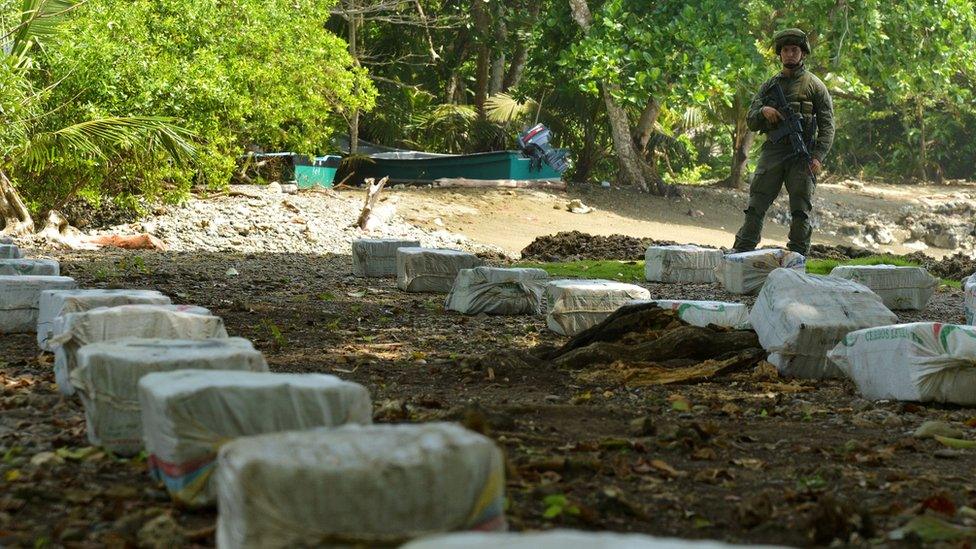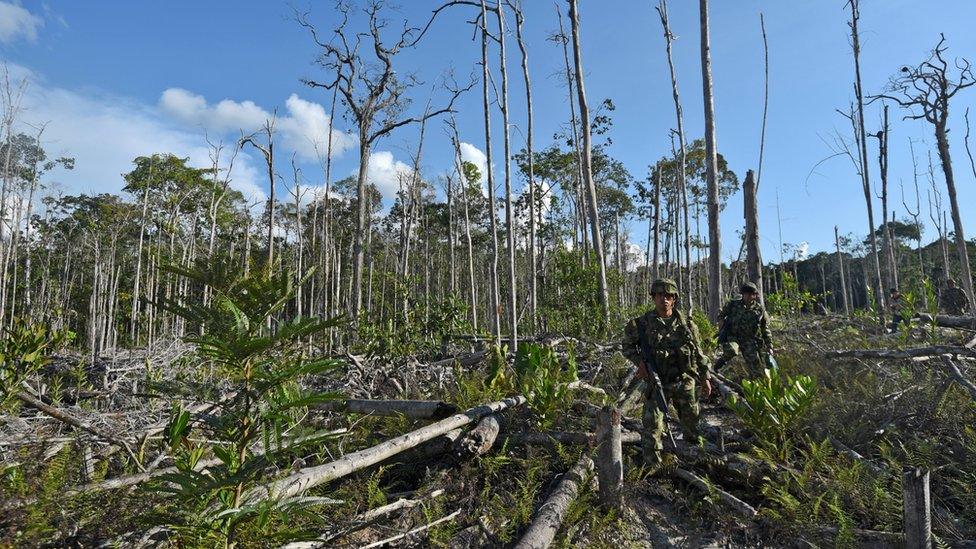Has Plan Colombia really worked?
- Published

Plan Colombia was implemented to end drug trafficking in Colombia
President Barack Obama will this Thursday meet with Colombia's president, Juan Manuel Santos, to mark 15 years of Plan Colombia.
The US-funded plan aims to solve the problem of drug trafficking and internal conflict in Colombia, in which more than 200,000 people have died.
The Colombian government believes it has been successful.
President Santos said so in an interview on national radio, calling it a "very useful and effective instrument" that has helped in Colombia's fight against drug trafficking.
US secretary of State John Kerry also praised the plan. In an opinion piece published by the Miami Herald, external, he said it had "helped to transform a nation on the verge of collapse into a strong institutional democracy with historically low levels of violence".
The initiative has met its goals in many ways, but it has also brought with it unexpected consequences. Here are eight.
1. More coca
According to the US non-governmental organisation, Washington Office on Latin America (Wola), Plan Colombia helped in the aerial fumigation of more than 1.6 million hectares of coca in the country, using the controversial herbicide glyphosate.
According to the World Health Organization (WHO), that might have put Colombia's population in danger because glyphosate is "probably carcinogenic".
And according to Wola, the fumigation strategy didn't even work.
Land cultivated with coca went up from 48,000 hectares in 2013 to 69,000 in 2014, the UN said.
Cocaine production does not appear to have gone down either - in 2015, Colombian security forces seized a record 252 tonnes of the drug.

The coca plant, native to south-west America, is used to make cocaine
The plan has made drug trafficking fragmented, making it harder to fight against, argues Diana Rojas, a specialist on Colombia-US relations from the National University of Colombia.
It also had international consequences, according to British journalist Johann Hari, who criticises the "war on drugs" in his work.
Mr Hari says that Plan Colombia has helped some of the narco-related violence move from Colombia to northern Mexico.
"If I was a Colombian, I'd be glad it wasn't happening here, but that is not a solution," he told the BBC.
2. More victims
Although the aim of Plan Colombia was to reduce violence, in the first eight years there was an increase in the number of victims affected by the internal conflict.
More than 800,000 people said they were victimised in 2008, according to the government's Unit for Victims.
From the total 7.8 million people registered with the Unit, about 75% said the crime they were subjected to took place during Plan Colombia.

The main culprit has been forced displacement, carried out mainly by guerrillas, paramilitary groups and illegal groups.
But there was a reduction in other forms of violence.
"I don't think in 2002 anyone in their right mind expected that by 2005, homicides would have been cut by almost half," said Adam Isacson, who produced the Wola report.
There was also a sharp drop in kidnappings and massacres.
3. Human rights violations
Plan Colombia provided funds that helped human rights organisations - but some argue that militarisation has only increased risks.
For Ricardo Vargas Meza, a Colombian sociologist who has studied the history of the plan, those worst-affected are civilians.
"There were very tough measures against the civilians, like food control," he explained.
The aim of that was to prevent the guerrillas from getting supplies through third parties, Mr Vargas Meza said.
The Wola report also points to the collaboration between Colombian security forces and paramilitary groups, as well as "false positive cases" (where civilians were killed by the army and passed as rebel fighters) and abuses by the intelligence services.
In the most recent years of Plan Colombia, though, the human rights situation has been improving.
4. Surge of illegal mining
While all the focus was on other security issues, illegal mining started to thrive and became an important source of income for illegal groups.
"That was never factored into Plan Colombia," said Mr Vargas Meza.

Colombia's ecosystem is under threat from illegal mining, which finances illegal armed groups
That was because the main sources of income for the rebel groups originally identified by the authorities were drug trafficking, kidnapping and extortion, he explained.
But the problem became serious only after 2007, with the increase in the price of commodities.
5. The threat of criminal gangs
With Plan Colombia already in place, between 2003-2006 about 30,000 men demobilised from paramilitary groups after an agreement with the government.
The process was partially successful.
A significant number of fighters - 15%, suggests the Wola report - became involved in what the government calls "Bacrims", or criminal gangs, focusing on drug trafficking and extortion.
Such is the power of some of these gangs, that the government has even authorised the use of air raids against them.
6. Soldiers turned mercenaries
Plan Colombia has a strong security forces training component, and because of that, Colombia has developed a very well-trained army and police force.
They now even train soldiers and officers from around the world and allow them to provide support to countries where the US has an interest in intervening.
However, there have been reports of Colombian soldiers quitting their jobs to offer their services as mercenaries - for example, joining the United Arab Emirates forces to fight in Yemen.

Military Plan
71% of the US investment for Plan Colombia went to:
Aerial mobility
Illicit crop eradication
Drug interdiction (air, sea, land and river)
Training and development
Intelligence
Training and maintenance centres
Source: Colombian Government and Wola

7. A non-exportable model
Washington thought that at some point, Plan Colombia could be successfully implemented in other countries, according to Mr Isacson, from Wola.
"The US looked at the Plan Colombia experience and hoped that it had found something it could apply in Afghanistan, or in Mexico, or Central America, and found out that it didn't work there," he said.
"Providing helicopters and training of a few units didn't work."

Plan Colombia has succeeded in training army and police forces
8. Influence over peace processes
There is a belief in Colombia that the tough offensive against Farc guerrillas, aided by Plan Colombia, weakened the rebel group to a point that forced it to negotiate with the government in Havana.
The two sides have been engaged in peace talks for the past three years.
But Virginia Bouvier, from the Washington-based United Institute of Peace, reads history differently.
When Plan Colombia was implemented in 2000, there was another peace process going on.
"I think the prospect of a militarised plan to strengthen the Colombian military at a time when peace was being negotiated tilted the balance of power towards the military," Ms Bouvier said.
Those peace talks failed - and so, for her, Plan Colombia "postponed the prospect of peace for another decade".
- Published17 June 2012

- Published27 May 2013
- Published17 May 2014
